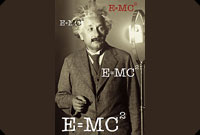|
|
|
-----------------
|
|
|
|
|
|
|
|
|
|
|
|
|
|
|
|
-----------------
|
|
|
|
|
|
|
|
|
|
Scientists resolve Einstein's E=mc2
Sat, 22 Nov 2008 14:51:52 GMT
|

Scientists have resolved Albert Einstein's e=mc2
|
Scientists
corroborate Einstein's E=mc2, using supercomputers to envision space
and time as part of a four-dimensional crystal lattice.
Led by Laurent Lellouch of the French Centre for Theoretical
Physics, researchers from France, Germany and Hungary proved Einstein's
1905 formula by special computations.
Using some of the world's mightiest supercomputers, the team
performed calculations to estimate the mass of proton and neutron
particles found in the nucleus of atoms.
The computations involve "envisioning space and time as part of a
four-dimensional crystal lattice, with discrete points spaced along
columns and rows," explained France's National Centre for Scientific
Research (CNRS) in a press release.
Protons and neutrons include smaller particles called quarks, which
are in turn bound by gluons. Since the mass of gluons is zero and the
mass of quarks five percent, the question is where is the missing 95
percent?
The new study showed that the energy from movements and
interactions of quarks and gluons can be converted into mass and vice
versa, AFP reported.
Thereby proving that as Einstein had proposed in his 1905 Special Theory of Relativity, energy and mass are equivalent.
The E=mc2 formula shows that mass can be converted into energy, and energy can be converted into mass.
Although the equation has been used many times and has been the
inspirational basis for building atomic weapons, it is the first time
that E=mc2 is resolved at the scale of sub-atomic particles.
TE/HGH
|
|
|
|
|
|